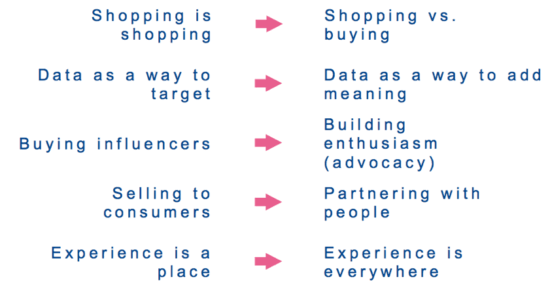

Essential
![]()
![]()
![]()
![]()
It’s no secret that the last few years have caused chaos for retailers globally. To survive you need a robust retail strategy that focuses on long-term and short-term profit for your business.
According to the Centre for Retail Research forecast in July 2021, total retail sales in 2020 will fall overall by -4.6% compared to 2019 (or a reduction of £17,281m). The level of retail sales will not regain last year’s level (2019) until 2022.
With reduced consumer spending, competition for retail marketers converting customers is tougher than ever. Marketers need the right tools, and skills, to optimize a winning digital marketing strategy and cut through the noise to convert even more customers online.
![]()
Starter Membership
Digital Experience Learning Path
Part of the Digital experience management Toolkit
Use a data-driven approach to improve the effectiveness of your website's digital experience
Of course, the rise of online is another major factor that has influenced the way consumers shop. Amazon, in particular, has single-handedly changed the way we think about and experience shopping. We now expect products at low prices, delivered quickly, and at a convenient time and place.
So, with changes in customer sentiment for shopping in-person, and increased martech retail ability, online retail has rocketed, as can be seen in the chart below US e-commerce as a percentage of all retail.

Although Amazon, Apple, and other online-only retailers are impacting physical retail stores, this by no means explains the overall decline (note that John Lewis, Tesco, and Marks & Spencer are three of the largest online stores in Europe ). The conversation should be less about how you compete online with Amazon and more about how to build a strategy to complete with retailing as a whole.
In 2018, Forbes’s Steve Dennis declared that it isn’t physical retailing but boring retail that’s dead and that this is a result of brands getting stuck in the middle . Whilst this was once an area of strength (consider British Home Stores or Woolworths, selling a huge range of products all under one roof), being something to a lot of people but ultimately not much to any of them is now a recipe for a broken retail strategy.
The key to success in retail today is to build into your strategy something to add value in ways that others simply can’t. If you want to attract prospective customers into your store (online or offline) you simply have to provide a differentiating advantage and a unique retail experience. Brands such as made.com and Fartech are now opening physical stores, and Joules, Pets at Home and Screwfix are all retail winners in the UK.
With so much competition, you need to stand out. Use the RACE Growth Process to win more customers

In January, I blogged about research conducted by McCann that revealed the new ‘truths’ of commerce against the backdrop of three fundamentals that have rem ained consistent over the last four years:

Whilst this research provides a clear overarching view of where retailers should focus their retail strategy, the next step is to look at the practical marketing implications of this insight.
According to Will Lockie, Global Head of e-commerce at Georg Jensen , retailers today need to think about how they can both find and execute an advantage over the dominant e-commerce giants such as Amazon. To do this, brands need to three-step approach:
Before you can start thinking about implementing anything truly different from the competition, you must first take a close look at what you're currently doing and ensure you are doing the basics well. The 2015 world cup winning All Blacks team is regarded as one of the greatest of all time. But it’s widely agreed that the key to the New Zealand team’s remarkable success was their ability to do the basics well.
Consumers today expect a baseline level of capabilities from retailers (e.g. ‘table stakes’) so it’s important to get these right:
If you don’t get these ‘ hygiene’ factors right you’ll be on the back foot, whereas success in this area will give you a platform to layer on additional capabilities. Will Lockie provides some helpful principles to follow when evaluating your choices:
Mastering the basics will give you a solid foundation, but in order to really stand out from the retail behemoths, you need to have a compelling brand story that can work over the long-term. This is something that McCann identified as part of their truth about retail research when they talk about creating meaningful retail relationships .
Being clear about your brand purpose and point of difference is key to attracting customers and reminding existing customers why they already shop with you. Think about the space you own as a brand that differentiates you from everyone else.
WHSmith is often seen as a dull, tired UK retailer. And yet Smiths, a British institution, is actually a major high street success story . The rise of Amazon, so damaging to brick and mortar retail, should pose a major threat to WHSmith’s sales of books, magazines, stationery, and gifts. Yet the brand has seen major growth by owning the travel sector (just consider Smith’s prevalence in airports and railway stations).
To compete with the major retailers, Will Lockie recommends asking the question “what c an't Amazon do?”:
Marks and Spencer’s complimentary bra-fitting service and Starbucks’s order and pay service are two examples of brands being useful for customers by serving that core purpose beyond ‘selling’. What can you do to be useful for customers in a new and different way?
Advanced ModuleDefine audience psychographics
Part of the Digital experience management Toolkit
Learn how to add psychographic profiling to personas and apply them to website designs and digital communications
Being ‘customer first’ is easy to say but very difficult to do (and maintain consistently) in practice. It’s a mantra you’ll hear every brand recite, yet to be truly customer-first you need to get the basics right, find a point of difference and genuinely listen to your customers.
Will Lockie sums this up nicely: “Customers don’t choose a product or service based on what you tell them, but based on what they experience”. This means that understanding and measuring customer satisfaction, listening to customer feedback and building these principles into your systems and technology are becoming increasingly important.
With 86% of consumers willing to pay more for better customer experience , retailers who ignore the voice of the customer will find themselves at a significant disadvantage.
Download our Business Resource – Multichannel retail proposition audit and competitor benchmarking template
This template is for online retailers who want to review and improve the effectiveness of their e-commerce site capability, including how they integrate with the other channels, which are part of today's omnichannel retail.
The retail experience in the UK is fracturing, with high streets seeing an increase in empty shops and declining footfall and we have no expectation for that to change any time soon.
Retailers, whether online, offline or a combination of the two, should focus on providing a shopping experience that excels at the basics, tells a meaningful brand story and meets customer expectations by listening to feedback and putting the voice of the customer into everything they do.
By Gavin Llewellyn
Gavin Llewellyn (LinkedIn) is an independent consultant. He is a Chartered Marketer who specialises in digital marketing, specifically in social media, SEO and online strategy. Gavin blogs at One Too Many Mornings where he offers advice, guidance and ideas on how individuals and companies can use digital marketing effectively to get found online, build engagement and generate conversion. You can Follow Gavin on Twitter.
This blog post has been tagged with:
Digital marketing strategy and planning ToolkitTurbocharge your results with this toolkit containing 11 resources

The Digital Marketing Strategy And Planning toolkit contains:



Start your Digital Marketing Plan today with our Free membership.